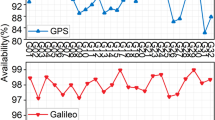Abstract
The quality of real-time GPS positions based on the method of precise point positioning (PPP) heavily depends on the availability and accuracy of GPS satellite orbits and satellite clock corrections. Satellite-based augmentation systems (SBAS) provide such corrections but they are actually intended to be used for wide area differential GPS with positioning results on the 1-m accuracy level. Nevertheless, carrier phase-based PPP is able to achieve much more accurate results with the same correction values. We applied SBAS corrections for dual-frequency PPP and compared the results with PPP obtained using other real-time correction data streams, for example, the GPS broadcast message and precise corrections from the French Centre National d’Etudes Spatiales and the German Deutsches Zentrum für Luft- und Raumfahrt. Among the three existing SBAS, the best results were achieved for the North American wide area augmentation system (WAAS): horizontal and vertical position accuracies were considerably smaller than 10 cm for static 24-h observation data sets and smaller than 30 cm for epoch-by-epoch solutions with 2 h of continuous observations. The European geostationary navigation overlay service and the Japanese multi-functional satellite augmentation system yield positioning results with biases of several tens of centimeters and variations larger by factors of 2–4 as compared to WAAS.






Similar content being viewed by others
References
Altamimi Z, Collilieux X, Métivier L (2011) ITRF2008: an improved solution of the International Terrestrial Reference Frame. J Geod 85:457–473. doi:10.1007/s00190-011-0444-4
Collins P (2008) Isolating and estimating undifferenced GPS integer ambiguities. Proc ION NTM 2008:720–732
Dow JM, Neilan RE, Rizos C (2009) The International GNSS service in a changing landscape of global navigation satellite systems. J Geod 83:191–198. doi:10.1007/s00190-008-0300-3
EGNOS (2009) EGNOS service definition document—open service, Version 1.0 (EGN-SDD OS V1.0). European Commission, Directorate-General for Energy and Transport, 1 October 2009
Geng J, Meng X, Dodson AH, Teferle FN (2010) Integer ambiguity resolution in precise point positioning: method comparison. J Geod 84:569–581. doi:10.1007/s00190-010-0399-x
GPS WAAS PS (2008) Global positioning system wide area augmentation system (WAAS) performance standard, 1st edn. Federal Aviation Administration (FAA)
Gurtner W, Estey L (2007) RINEX: the receiver independent exchange format, Version 2.11. Astronomical Institute, University of Berne, Switzerland and UNAVCO, Boulder, CO
Hauschild A (2010) Precise GNSS clock-estimation for real-time navigation and precise point positioning. Dissertation, Technische Universität München
Heßelbarth A, Wanninger L (2008) Short-term stability of GNSS satellite clocks and its effects on precise point positioning. Proc ION GNSS 2008:1855–1863
Hilla S (2010) The extended Standard Product 3 Orbit Format (SP3-c). National Geodetic Survey, Silver Spring
ICAO (2010) Aeronautical information services, Annex 15 to the Convention on Civil Aviation, 13th edn. International Civil Aviation Organization (ICAO), July
IS-GPS-200 (2010) Navstar GPS Space Segment/Navigation User Interfaces, Interface Specification IS-GPS-200 Revision E. GPS Wing (GPSW) Systems Engineering and Integration, June 8
Kouba J (2009) A Guide to using International GNSS Service (IGS) Products. International GNSS Service (IGS), Version 2.1
Laurichesse D (2011) The CNES real-time PPP with undifferenced integer ambiguity resolution demonstrator. Proc ION GNSS 2011:654–662
Merrigan MJ, Swift ER, Wong RF, Saffel JT (2002) A refinement to the World Geodetic System 1984 Reference Frame. Proc ION GPS 2002:1519–1529
Nakaitani K (2009) MSAS operation (in Japanese), Navigation, Japan Institute of Navigation 170:32–35
Plag H-P, Bockmann L, Kierulf HP, Nørbech T, Johansson JM, Lidberg M, Cruz del Valle A, Brocard D (2006) The EGNOS geodetic reference frame: principles and methodology. In: Ventura-Traveset J, Flament D (eds) EGNOS—the European geostationary navigation overlay system: a cornerstone of Galileo. European Space Agency SP-1303, pp 83–99
Ray J, Gurtner W (1998) Proposed RINEX extensions to handle clock information. USNO, Washington, DC (Astronomical Institute, University of Berne, Switzerland)
Rebischung P, Griffiths J, Ray J, Schmid R, Collilieux X, Garayt B (2012) IGS08: the IGS realization of ITRF2008. GPS Solut, in print. doi:10.1007/s10291-011-0248-2
Rho H, Langley RB (2007) The usefulness of WADGPS satellite orbit and clock corrections for dual-frequency precise point positioning. Proc ION GNSS 2007:939–949
RTCA (2006) Minimum operational performance standards for global positioning system/wide area augmentation system airborne equipment, DO-229D. Radio Technical Commission for Aeronautics (RTCA), Washington, DC
RTCM (2011) Differential GNSS (Global Navigation Satellite Systems) Services—version 3 + 5 amendments. Radio Technical Commission for Maritime Services (RTCM) 10403.1, Arlington, VA
Suard N, Gurtner W, Estey L (2004) Proposal for a new RINEX-type exchange file for GEO SBAS Broadcast Data. CNES, Toulouse, France, Astronomical Institute, University of Berne, Switzerland (UNAVCO, Boulder)
Toran-Marti F, Ventura-Traveset J (2004) EGNOS Message Server (EMS) User Interface Document. ESA GNSS-1 Project Office, E-RD-SYS-E31-011-ESA, Toulouse
Ventura-Traveset J, Gauthier L, Toran F, Michel P, Solari G, Salabert F, Flament D, Auroy J, Beaugnon D (2006) The European EGNOS project: mission, programme and system. In: Ventura-Traveset J, Flament D (eds) EGNOS—the European geostationary navigation overlay system: a cornerstone of Galileo. European Space Agency SP-1303, pp 3–19
WAAS (2001) Specification for the wide area augmentation system (WAAS). Federal Aviation Administration, DTFA01-96-C-00025, August 13
Zumberge JF, Heflin MB, Jefferson DC, Watkins MM, Webb FH (1997) Precise point positioning for the efficient and robust analysis of GPS data from large networks. J Geophys Res 102(B3):5005–5017. doi:10.1029/96JB03860
Acknowledgments
The following institutions are acknowledged for providing GPS satellite orbits and clock corrections and GPS observation data sets: International GNSS Service (IGS), Center National d’Etudes Spatiales (CNES), Deutsches Zentrum für Luft- und Raumfahrt (DLR), European Space Agency (ESA), Electronic Navigation Research Institute (ENRI), US National Geodetic Survey (NGS), EUREF Permanent Network (EPN), Crustal Dynamics Data Information System (CDDIS), German Federal Agency for Cartography and Geodesy (BKG).
Author information
Authors and Affiliations
Corresponding author
Rights and permissions
About this article
Cite this article
Heßelbarth, A., Wanninger, L. SBAS orbit and satellite clock corrections for precise point positioning. GPS Solut 17, 465–473 (2013). https://doi.org/10.1007/s10291-012-0292-6
Received:
Accepted:
Published:
Issue Date:
DOI: https://doi.org/10.1007/s10291-012-0292-6




